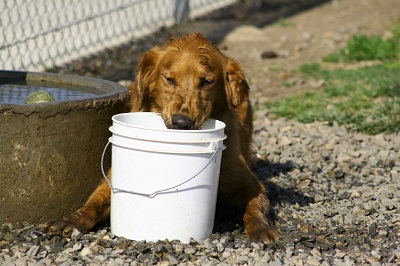
Summer temperatures are soaring! Even the short walk from the veterinary clinic to my car makes me hot enough to need a cool drink of water. Just imagine how the dogs staying outdoors during the summer feel! They get overheated, too!
Overheating goes by many names including heat exhaustion, heat stroke, or heat prostration. No matter what you call it, overheating means trouble for dogs. Getting overheated can cause more than just a little discomfort. Extreme heat can make pets quite ill and elevated body temperatures can even be fatal.
Causes of Heat Stroke
Heat stroke is more likely to occur when both temperature and humidity are high. Increased humidity raises relative temperatures to unbearable levels. If you live in a hot, humid area, your dog is more at risk of heat exhaustion.
When a dog experiences heat exhaustion, his temperature may rise rapidly from normal (approximately 101.5 degrees F) to 104-105 degrees F. At this point, the dog loses the ability to regulate his body temperature, which continues to rise. High body temperature can potentially harm internal organs. Without a quick, appropriate cool down, major organs may be irreversibly damaged, resulting in death.
Why Dogs Are More Prone to Heat Exhaustion than People
Even though we get hot outside, we aren’t as likely to have a heat stroke as our dogs because dogs don’t regulate their temperature the same way we do. When you become overheated, you perspire. The perspiration evaporates to help cool your body.
Our canine friends don’t perspire. Dogs dissipate excess body heat by panting – which doesn’t cool as efficiently as good old sweating. Plus, they’ve got a fur coat on! They can’t take off their fur coat. They can’t turn on the fan. They can’t fill their own water bowls. See why dogs are prone to heat exhaustion?
Preventing Heat Stroke
It’s our responsibility to provide adequate protection from the summer heat for our pets, especially those that spend lots of time outdoors.
First, make sure there is ample shade in the yard and train your dog to rest in this area by placing his water bowl and toys under a large tree, covered patio or canopy. Second, provide a constant source of fresh water and keep it cool by occasionally adding a few ice cubes to the bowl. Third, if your yard doesn’t benefit from a nice breeze, create adequate ventilation with a fan. Be careful to keep electrical cords out of your dog’s reach.
Some dogs find a quick dip in the water very refreshing. Scout uses our backyard fountain to cool off, but a plastic kiddie pool works just as well. If you have a real swimming pool, train your dog to use the swim out or steps. Dogs don’t climb ladders and accidental drownings occur every summer as dogs exhaust themselves treading water when they can’t find a way out of the pool.
Exercise with caution during warm months. Try walking your dog in the early morning or late evening when the temperature is cooler. Take shorter walks or runs than usual. Stop for frequent water breaks. Avoid the “sunny side of the street” and find a more shaded area to exercise. Bring along a mister and spray your dog during exercise sessions. When you return home, you can give your dog a good spray with the water hose. But remember that water left in the hose becomes very hot, so let the water flow for a few minutes before spraying your dog.
How to Recognize the Signs of Heat Stroke
It’s important for you to recognize the warning signs of heat stroke. Pets that suffer heat stroke may have these symptoms:
- Excessive panting
- Pale gums
- Increased heart rate
- Drooling thick, ropey saliva
- Vomiting
With severe heat exhaustion, dogs experience serious breathing difficulties and may become disoriented or non-responsive. They may collapse and be unable to move. In the most difficult cases, dogs become comatose and die.
Emergency At-Home Treatment for Heat Prostration
If you notice any of these symptoms in your dog, provide emergency care. Immediately move your dog to a cooler area inside an air-conditioned house, under a shaded covering, or in front of a fan. Wet him with cool (not ice cold) water. Either immerse him in a tub of water or gently wet him with a hose. Do not force him to drink water. Saturate his foot pads with alcohol. If you can, monitor his temperature with a rectal thermometer. When he cools down to a safer temperature (102-103 degrees), place wet towels on him and proceed immediately to your veterinarian.
Hospital Treatment for Heat Exhaustion
Rapid response may cool your dog off, but his core body temperature may have reached a critical level before your intervention. It’s important for dogs to see their doctor even if they look normal after an overheating episode.
Your veterinarian will begin other lifesaving measures in the hospital to avoid potential organ damage. Your pet’s doctor may start an IV of rehydrating fluids, give medications to stabilize respiration and treat shock. Your veterinarian may suggest a hospital stay for further treatment and laboratory tests to assess organ function.
Predisposition to Heat Stroke
Any dog is prone to heat stroke, but some are more susceptible than others. The very young or very old tend to have more difficulties with overheating, as do the overweight. Dogs with short noses such as Boston Terriers, Pugs, Bulldogs, and Shih Tzus don’t dissipate heat as well as long-nosed breeds. And, of course, dogs with thick coats such as Huskies or St. Bernards get quite warm. These dogs need extra attention during warm weather.
Enjoy the Summer
Summer is a great time to be outdoors. It can be even more fun if we remember to take precautions to prevent heat exhaustion for ourselves AND our pets.
